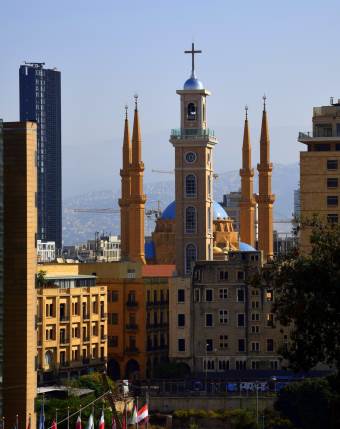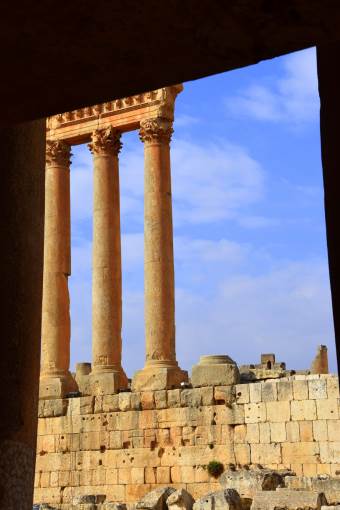Lebanon

General Info
Last visitedNovember 2019
FoodA typical Lebanese breakfast consists of labneh, a yogurt paste, feta as well as other types of white cheese, tomatoes, cucumbers, ful and similar dishes with beans and chickpeas. For lunch or dinner people order mezze. Two or three plates per person will do, all shared with the group. Alcoholic beverages such as beer, wine, arak are available in the non-Muslim districts and towns. There are numerous bars and pubs in Beiruts Hamra, Gemmayzeh and Achrafieh districts.
TransportMost of the people travel by taxi. Prices must be negotiated beforehand. You pay about 25 to 30 USD from the airport to downtown. There are about a dozen bus routes in the city. A trip generally costs 1000 LBP (0.8 USD). There are no bus-stops. You can get on and off anywhere en route. Minibuses operate along the coast and to the Bekaa valley. A trip costs 2000 LBP in general. Various tour operators promote excursions to Baalbek, Byblos and to the cedars.
PeopleMany Lebanese people speak English fairly well. French is also quite common. Foreigners are generally left alone. There is little hassle, little bargaining compared to other countries in the region. Military and police are present all everywhere. There are lots of checkpoints. Foreigners are treated with politeness. Lebanese are heavy smokers. They smoke everything and everywhere, starting with their first sheesha for breakfast. Young men show off with motorcycles and tuned German cars. They like to do races. Even bus drivers chase each other and put their passengers in danger.
Political SituationMore than 2 million refugees live in Lebanon. Syrians are joining the Palestinians since civil war broke out in the neighbouring country. Unemployment is high. Young people in particular find hardly any work. They prefer being unemployed to having underpaid jobs which are mostly executed by Filipinos. Citizens are currently protesting against their government which is corrupt and inefficient. They meet at Martyrs' Square every day, escort through the streets and block crossroads. Police and military keep observing the situation but do not interfere. Despite protestors, refugees and high unemployment, foreigners feel relatively safe.
Do...eat oriental food starting with a wonderful breakfast.
go for a sunset at the pigeon rock.
think you can practice your rudimentary Arabic, since most of Lebanese speak English.
Lebanon
Lebanon is also called Switzerland of the Middle East. The country is small, maybe that's why. You can easily reach any border from Beirut within two hours. The coast is similar to the Côte d'Azur. Settlements stretch high up along the coastal mountains. From Beirut you can reach heights of almost 2000m in half an hour's drive. Ski resorts are less than 2 hrs drive away from the capital.
Beirut
Between sea and mountains, the suburbs grow up along the slopes of Mount Lebanon. The city center consists of muslim, christian and armenian quarters. Citizens populate the Corniche, the broad coastal road, in the evenings and on weekends. Sunsets over the pigeon cliffs are legendary. Memorials of the past civil war are still present. Ruins and bombed-out bunkers can be found in the center along the "Green Line". Military barricades and barbed wire fences are serving their purpose again during the current mass protests.
Hamra is Beirut's lively western quarter with its numerous restaurants, pubs, shops and hotels.
Landmarks of downtown around Martyrs' Square are the Great Mosque (Muhammad Al-Amine) and St. George Cathedral right next to it. Close by is one of the civil war memorials, the so called Beirut Dome, an oval bunker.
Gemmayzeh and Achrafieh are upper middle class quarters in the east of downtown. Bohemians feel at home here with lots of restaurants and galleries. That's probably one of the reasons why Beirut is called Paris of the middle east.
The pigeon rocks stand spectacularly in the surf below the corniche. At sunset, folks meet here for a photo shoot.
Archeological sites
The Roman site of Baalbek, called Heliopolis, is one of its most impressive and magnificent. The 6 mighty pillars of the Jupiter temple are fascinating. The Bacchus Temple is a masterpiece of its kind. You feel like a dwarf in front of such mighty buildings. Also worth a visit are the sites at Aanjar, Tyre and Byblos.
Qadisha valley
Numerous Christian towns scatter the slopes of the valley, most famous is Bcharré with its towering Mar Saba church and the Khalil Gibran Museum nearby. At the very end of the valley is a small cedar forest, one of the few places where the national symbol is still present nowadays. Apart from the cedars, the rock monastery Deir Mar Antonios Qozhaya is another recommended sight. The ancient church is built at a rock.
Tyre
UN troops are omnipresent at the southernmost city in Lebanon and watch the border to Israel. Apart from the two Roman sites its small Christian quarter near the old harbor with its colorful flower pots, doors and facades is worth a visit.
Sidon
A landmark is its sea castle. Souk and medina with their maze of alleyways are particularly interesting. Posters of Yasser Arafat are still existing.
Byblos
The oldest town in the world. Most of the houses have been renovated while maintaining the style of the time. The archaeological site is worth visiting especially its crusader castle. Don't miss to descend to the underworld of necropolis.
Links and recommendations
Nakhal travel - Tours to Baalbek, the cedars and other sites.
Saifi institute - Recommended school to learn Arabic languages (formal as well as urban arabic).
Hamra Urban Gardens hotel - Recommended hotel at Hamra district.
Recommended Novel (in German): Pierre Jarawan - Am Ende bleiben die Zedern.

St George cathedral and Muhammad al Amine Mosque - Beirut

Jupiter Temple - Baalbek